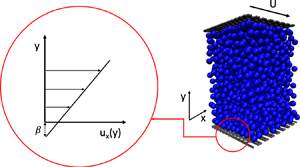Crossref Citations
This article has been cited by the following publications. This list is generated based on data provided by
Crossref.
Zhdanov, Vladimir P.
2022.
Diffusion-limited association of nanoparticles in fluid: Beyond the no-slip boundary conditions.
Colloid and Interface Science Communications,
Vol. 46,
Issue. ,
p.
100538.
Corral-Casas, Carlos
Li, Jun
Borg, Matthew K.
and
Gibelli, Livio
2022.
Knudsen minimum disappearance in molecular-confined flows.
Journal of Fluid Mechanics,
Vol. 945,
Issue. ,
Ceccacci, Silvia
Calabretto, Sophie A.W.
Thomas, Christian
and
Denier, James P.
2022.
The effect of slip on the development of flow separation due to a bump in a channel.
Journal of Fluid Mechanics,
Vol. 951,
Issue. ,
Hadjiconstantinou, N. G.
and
Swisher, M. M.
2022.
On the equivalence of nonequilibrium and equilibrium measurements of slip in molecular dynamics simulations.
Physical Review Fluids,
Vol. 7,
Issue. 11,
Hadjiconstantinou, N.G.
and
Swisher, M.M.
2022.
An atomistic model for the thermal resistance of a liquid–solid interface.
Journal of Fluid Mechanics,
Vol. 934,
Issue. ,
Sun, Chengzhen
Zhou, Runfeng
and
Bai, Bofeng
2023.
How to accurately predict nanoscale flow: Theory of single-phase or two-phase?.
Physics of Fluids,
Vol. 35,
Issue. 1,
Ren, Junjie
Wang, Shengzhen
Wu, Qingxing
and
Song, Yinan
2023.
Axisymmetric lattice Boltzmann model for liquid flows with super-hydrophobic cylindrical surfaces.
European Journal of Mechanics - B/Fluids,
Vol. 98,
Issue. ,
p.
120.
Zhdanov, Vladimir P.
2023.
Unification: Viscosity, permittivity, and hydration forces near an interface.
Modern Physics Letters B,
Vol. 37,
Issue. 14,
Kizilova, Natalya
2023.
Nanomaterials and Nanocomposites, Nanostructure Surfaces, and Their Applications.
Vol. 279,
Issue. ,
p.
43.
Hadjiconstantinou, Nicolas G.
2024.
Molecular Mechanics of Liquid and Gas Slip Flow.
Annual Review of Fluid Mechanics,
Vol. 56,
Issue. 1,
p.
435.
Corral-Casas, Carlos
Chen, Yichong
Borg, Matthew K.
and
Gibelli, Livio
2024.
Density and confinement effects on fluid velocity slip.
Physical Review Fluids,
Vol. 9,
Issue. 3,






